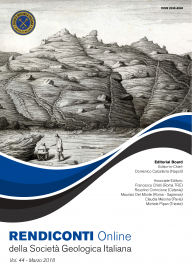
"Dighe di pece e di asfalto": bitumen exploitation history in the Abruzzo region (Central Italy) across the 20th century
Lorenzo Lipparini (1), Francesco Gerali (2) & Roberto Bencini (3)
(1) University of Rome La Sapienza, Earth Science Department. P.le A. Moro, 5 - 00185 Rome (Italy).
(2) The University of Oklahoma College of Law. Oil & Gas, Natural Resources, and Energy Center; The University of Western Australia, FABLE.
(3) GA.I.A. Srl, Via Lucrino, 25, Rome (Italy).
Corresponding author e-mail: lorenzo.lipparini@uniroma1.it.
Volume: 44/2018
Pages: 58-63
Abstract
In this article we present the history of the exploration and exploitation of solid hydrocarbons in what has been known for a long time as the Bacino Minerario Abruzzese (Abruzzo petroleum district), in Central Italy, in the first part of the 20th century.
From the antiquity, bitumen and asphalt were locally collected from surface seeps. Industrial scale extraction started in the second half of the 19th century, with Italian and foreign companies. After
World War I, the Italian government repossessed the bitumen exploitation concessions hold by foreigners and re-assigned them to Italian entities. Afterwards, during the Fascist period, the government stepped up the pace of industrial development under the "autarky" (self-sufficiency) policy.
From a technical standpoint, positive results were achieved thanks to the continuous support of geological evaluation studies. Also today these areas represent an important calibration and analogue forgeoscientists to evaluate hydrocarbon residual potential in the whole region.
The title of this article was inspired by the words used by geologist Giovanni Capellini (1833-1922) in his historical evaluation work of the bitumen deposits of the Maiella Mountain north-west
flank (Capellini, 1866).
Keywords
Get Full Text